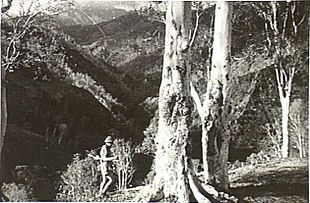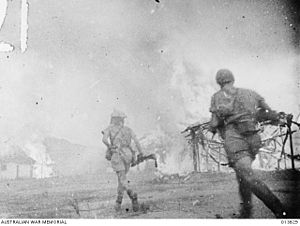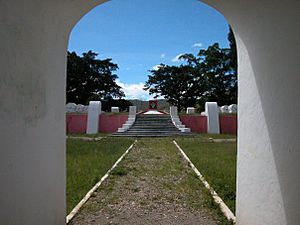Battle of Timor facts for kids
Quick facts for kids Battle of Timor |
|||||||
|---|---|---|---|---|---|---|---|
| Part of the Dutch East Indies campaign | |||||||
 An Australian commando, possibly Sergeant Bill Tomasetti of the 2/2nd Independent Company, in typical mountain terrain on Timor, on 12 December 1942. (Photograph by Damien Parer.) |
|||||||
|
|||||||
| Belligerents | |||||||
| Allies |
|
||||||
| Commanders and leaders | |||||||
(invasion) (later campaign) |
|||||||
| Strength | |||||||
| ~ 2,050 strong garrison (peak February 1942) ~ 1,000 commandos (peak October 1942) |
~ 12,000 (peak late 1942) | ||||||
| Casualties and losses | |||||||
| Netherlands: ~ 300 dead Australia: 151 dead (Sparrow Force) Portuguese Timor: ~ 75 dead United Kingdom: 5 dead (The Sparrows) |
~ 4,000 dead (West & East Timor) |
||||||
| 40,000–70,000 civilian dead | |||||||
The Battle of Timor was a fight during World War II on the island of Timor. It happened between February 1942 and February 1943. Japan invaded the island, which was then split between Portugal and the Netherlands. A small group of Allied soldiers, mostly from Australia, the United Kingdom, and the Dutch East Indies, tried to stop them. This group was called Sparrow Force.
Even though the Allies fought hard, the Japanese took control of Timor. However, some Australian commandos kept fighting a special kind of war, using surprise attacks from the mountains. They got supplies from Darwin, Australia, across the Timor Sea. This fighting kept a large Japanese army busy on Timor for many months. Many Timorese people helped the Allies, even though Portugal was officially neutral. Because of this, many Timorese civilians suffered greatly during the Japanese occupation, which lasted until 1945.
Contents
Why the Battle of Timor Happened
By late 1941, Timor was divided. The eastern part was controlled by Portugal, and the western part by the Netherlands. The Dutch had about 500 soldiers, and the Portuguese had only 150. Australia and the Netherlands agreed that if Japan joined World War II, Australia would send troops to help defend Dutch Timor. Portugal wanted to stay neutral.
After Japan attacked Pearl Harbor, a small Australian force, called Sparrow Force, arrived in Dutch Timor on December 12, 1941. This force had about 1,400 men, including the 2/40th Battalion and a commando unit called the 2nd Independent Company. They joined Dutch soldiers already there.
Portugal did not want to cooperate with the Allies at first. But because the Allies needed to protect their side, a combined Dutch-Australian force moved into Portuguese Timor on December 17. Portugal protested, but the local governor pretended to be a prisoner to keep up the idea of neutrality. Most of the Dutch troops and the 2/2nd Independent Company then moved into Portuguese Timor.
Japan had not planned to invade neutral Portuguese Timor. But after the Allies moved in, Japan decided to attack. Portugal tried to send its own troops to Timor, but the Japanese invasion happened before they could arrive.
Getting Ready for Battle
In January 1942, the Allied forces on Timor became an important part of the "Malay Barrier." This was a line of defense against the Japanese. More Australian support staff arrived, and Brigadier William Veale became the Allied commander on Timor. Many of the Australian soldiers were not used to the tropical weather and got sick.
The airfield at Penfui in Dutch Timor was a key link between Australia and American forces fighting in the Philippines. Japanese planes attacked Penfui several times, but British anti-aircraft guns and American fighter planes helped defend it. More Dutch troops and British anti-aircraft gunners also arrived to help.
Other Allied forces in the region, like those on Ambon and Rabaul, were defeated by the Japanese. On February 16, a group of Allied ships bringing more soldiers and supplies to Timor was attacked by Japanese planes. They had to turn back. This meant Sparrow Force could not get more help. Timor seemed like the next target for the Japanese.
The Battle Begins
Japanese Invasion of Portuguese Timor
On the night of February 19-20, 1942, about 1,500 Japanese soldiers landed in Dili, the capital of Portuguese Timor. The Allies were surprised because they thought the ships were Portuguese reinforcements. However, the Allies were ready. An 18-man Australian commando group at the airfield fought back, killing many Japanese soldiers.
Other Australian commandos were caught off guard at a roadblock. Most of them were killed after surrendering. The remaining Australians moved into the mountains. The Dutch commander, Lieutenant Colonel Nico van Straten, and 200 Dutch soldiers also headed towards the border.
Japanese Landings in Dutch Timor
On the same night, Japanese planes heavily bombed Dutch Timor. The small Australian air force had to leave. Then, about 4,000 Japanese soldiers landed on the southwest side of the island. They had tanks to help them. They quickly moved north, cutting off Dutch positions and attacking the 2/40th Battalion at Penfui.
Japanese paratroopers also landed near Usua, east of Kupang, trying to block the Allied retreat. Sparrow Force headquarters moved further east. The 2/40th Battalion fought fiercely against the paratroopers, even using bayonets. They managed to defeat most of the paratroopers.
The 2/40th Battalion continued to retreat, but Japanese tanks attacked them. Two Japanese bombers accidentally bombed their own tanks, destroying three of them. Later, the Australians were surrounded by Japanese soldiers. With low ammunition and many wounded, their commander, William Leggatt, surrendered. Many of his soldiers died as prisoners of war. However, Veale and about 290 Australian and Dutch troops escaped and joined the 2/2nd Independent Company in Portuguese Timor.
Australian Commandos Fight Back
By the end of February, Japan controlled most of Dutch Timor and the area around Dili. But the Australian 2/2nd Independent Company was still fighting in the mountains of Portuguese Timor. These commandos were trained for special operations. They used surprise attacks against the Japanese, helped by Timorese guides and local people.
The local Portuguese officials and Timorese people often helped the Allies. They let the Allies use their telephone system to gather information on Japanese movements. At first, the Allies couldn't contact Australia. But the local Qantas agent, David Ross, helped them. He found the commandos and gave them information about the Japanese. He also gave them a note promising that Australia would pay anyone who helped them.
In March, the forces of Veale and Van Straten joined the 2/2nd Company. They managed to build a radio, nicknamed "Winnie the War Winner," and contacted Australia. By May, Australian planes were dropping supplies to the commandos.
The Japanese sent a famous soldier, known as the "Tiger of Singapore," to Timor. On May 22, the "Tiger" led a Japanese force towards Remexio. Australian patrols, with help from Portuguese and Timorese, set up an ambush and killed some Japanese soldiers. In a second ambush, an Australian sniper killed the "Tiger." The Japanese force retreated.
In June, General Douglas MacArthur decided that a full attack to take back Timor would need a very large army. So, it was decided to keep supporting the commandos for as long as possible, but not to send a huge invasion force.
Relations between the Portuguese governor and the Japanese got worse. The Japanese complained that the governor was not punishing people who helped the Australians. The Japanese commander even complimented the Australian commandos, comparing them to the Afrikaner commandos in the Second Boer War. He admitted it would take a force 10 times larger to defeat them.
Japanese Counter-Attack
In August, a large Japanese force, the 48th Division, arrived from the Philippines. They launched a major attack to push the Australians to the south coast. Japanese columns moved from different directions. The Japanese also started getting many Timorese civilians to help them, who gave information about Allied movements.
In September, the Australians sent more soldiers, the 450-strong 2/4th Independent Company, also known as "Lancer Force." When they landed at Betano, their ship, the destroyer HMAS Voyager, got stuck and had to be left behind after Japanese air attacks. Its crew was rescued.
By October, the Japanese were using many Timorese civilians in their attacks. These civilians suffered many casualties. The Japanese also pressured Portuguese civilians to help them. They even ordered all Portuguese civilians to move to a "neutral zone." This only made the Portuguese more willing to help the Allies.
In November, the Allies approved giving weapons to Portuguese officials. The commander of the 2/2nd Company, Major Bernard Callinan, became the Allied commander in Timor. On November 30, the Australian Navy tried to land new Dutch troops and evacuate Portuguese civilians. But one of the ships, HMAS Armidale, was sunk by Japanese planes, and almost everyone on board was lost.
Australian Soldiers Leave Timor
By the end of 1942, it was clear that the Allies could not easily take back Timor. There were 12,000 Japanese soldiers on the island, and the commandos were facing more and more attacks. The Australian military leaders believed it would take at least three large Allied divisions to recapture the island. Also, Australia was fighting other tough battles in New Guinea. So, it was decided to slowly pull out the Australian forces from Timor.
On December 11-12, most of the original Sparrow Force soldiers were evacuated with Portuguese civilians. In January 1943, the Lancer Force was also told to leave. On January 9-10, most of the 2/4th and 50 Portuguese were evacuated. A small intelligence team, called S Force, stayed behind. They were evacuated by an American submarine on February 10, 1943. About 40 Australian commandos died during this time, while around 1,500 Japanese soldiers were believed to have died.
What Happened After
The Battle of Timor did not change the overall war much, but the Australian commandos kept a whole Japanese division busy on Timor. This stopped them from fighting in other important places like New Guinea. The battle showed that small, special operations could be very effective, especially when the Allies didn't have enough resources for bigger attacks.
The Japanese controlled Timor until they surrendered in September 1945, after the atomic bombings of Hiroshima and Nagasaki. On September 5, 1945, the Japanese commander met the Portuguese Governor, giving power back to him. On September 11, Australian forces arrived and accepted the surrender of all Japanese forces on Timor. Later, on September 27, a Portuguese military force arrived to help rebuild Timor.
Most civilian deaths during the occupation were caused by Japanese actions against the local people. It is estimated that between 40,000 and 70,000 Timorese civilians died.
See also





